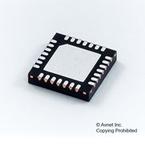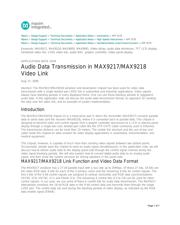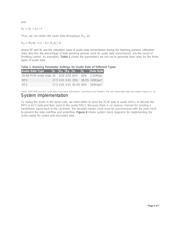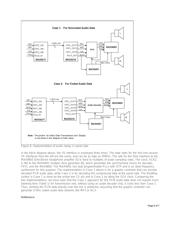下载

Maxim > Design Support > Technical Documents > Application Notes > Automotive > APP 3578
Maxim > Design Support > Technical Documents > Application Notes > High-Speed Interconnect > APP 3578
Maxim > Design Support > Technical Documents > Application Notes > Oscillators/Delay Lines/Timers/Counters > APP 3578
Keywords: MAX9217, MAX9218, MAX9850, MAX9491, Video dislay, audio data trsmission, TFT LCD display,
Serialized video link, LVDS video link, audio DAC, graphic controller, Video panel display
APPLICATION NOTE 3578
Audio Data Transmission in MAX9217/MAX9218
Video Link
Aug 17, 2005
Abstract: The MAX9217/MAX9218 serializer and deserializer chipset has been used for video data
transmission with a single twisted-pair LVDS link in automotive and industrial applications. Video signals
always have blanking periods in every displayed frame. One can use those blanking periods to 'piggyback'
audio data. In this application note, we discuss the audio data transmission format, an approach for sending
the data over the video link, and an example of system implementation.
Introduction
The MAX9217/MAX9218 chipset [1] is a transceiver pair in which the transmitter (MAX9217) converts parallel
data to serial data sent the receiver (MAX9218), where it is converted back to parallel data. This chipset is
designed to transmit video and control signals from a graphic controller (processor) to a LCD or plasma panel
display through a single low-cost, twisted-pair cable like the UTP-CAT5 cable commonly used in Ethernet.
The transmission distance can be more than 10 meters. The simple link structure and the use of low-cost
cable made this chipset an ideal solution for video display applications in automotive, instrumentation, and
medical equipment.
This chipset, however, is capable of much more than sending video signals between two distant points.
Occasionally, people want the chipset to send an audio signal simultaneously. In this application note, we will
discuss how to deliver audio data to the display panel side through the control signal channel during the
video signal-blanking periods. We will also explain how to convert digital audio data to an analog audio
signal, and then show the system structure for driving speakers in the panel side.
MAX9217/MAX9218 Link Function and Video Data Format
The MAX9217 serializer has a 27-bit parallel input with a bus rate up to 35Mbps. Of these 27 bits, 18 bits are
the video RGB data: 6 bits for each of the 3 primary colors and the remaining 9 bits for control signals. The
first 3 bits of the 9-bit control signals are assigned to vertical, horizontal, and RGB data synchronizations:
VSYNC (C0), HSYNC (C1) and ENAB (C2). The remaining 6 control bits (C3 to C8) can be used for other
control signals. In our case, we use some of these 6 control bits for audio data transmission. The MAX9217
alternatively serializes the 18-bit RGB data or the 9-bit control data and transmits them through the single
LVDS pair. The control data are sent during the blanking periods of video display, as indicated by the RGB
data enable signal (ENAB).
Page 1 of 7








